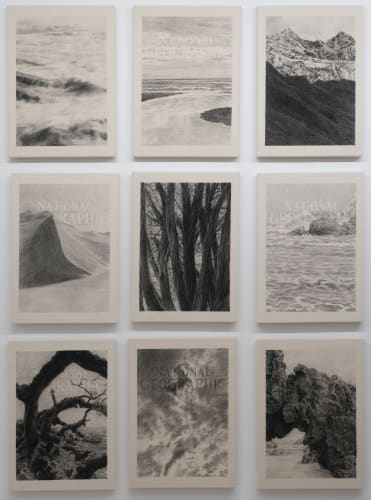Claudia Coca: Landscapes of Desire and Oblivion: 251 W 19th St
Ethan Cohen Gallery is pleased to present Landscapes of Desire and Oblivion, the first New York solo exhibition of the leading Peruvian artist Claudia Coca. Coca’s work provokes critical reflection on contemporary political and cultural issues surrounding colonialism, race, gender, and citizenship.
Claudia Coca is a Peruvian artist whose artistic practice reflects on age-old colonial strategies of portraying colonized peoples as “barbarians” or “exotic”. Utilizing visual images and the written word, she subverts the imaginarium of dispossession relating to the wild, the perceived ugly, and the besmirched. The objective of her work is to catalyze the abandonment of colonial concepts and catalyze reconciliation with the historical representation of indigenous peoples, with the otherized body and geography.
Coca states, “The body and memory are conquered territories. The colonizer's recurrent visualizations of geographies and bodies is a limitless invitation for their (re)conquest.” The series Cuentos Bàrbaros are conceptual landscapes that portray subject territories as abject geographies, zones that the “the American savage inhabits”. Coca argues that borders and territories as divided up in the collective consciousness of our societies are the landscape of the Other, the ‘savage’, and the ‘Indian’- a phenomenon deeply embedded in Latin American thought. By painting and drawing, reproducing and slyly subverting, colonial images of representation.
Coca investigates the idea of the ‘wild’, and the multiplicity of forms that it takes. Her work explores the colonialist approach to seeing and representation. Visually capturing nature, the body, the landscape, and the geography were inherently assumed to be positive concepts, even though the idea of the “exotic”, “the primitive”, was always enfolded in them, informed by the idea of the savage, or the “good savage”.
Her installation “The Gift” or “New Spain’s Illustrations” consists of fifteen pieces appropriating 17th-century Spanish paintings and drawings, arranged on tables in a U-shaped progression, showing geographical, botanical, and zoological images. Overall, they reframe anthropologized depictions of ‘originary nations’ and their environments. The visitor is immersed in the installation, proceeding towards the base of the U in a replicated narrative of 'discovery' finally encountering the last three works. Two of them ironically re-portray early portraits of Native Americans. The last work, the centerpiece of the installation, is an appropriated re-presentation of the renowned painting The Viceroy’s Daughter, in effect subjecting the colonizer to its own aesthetics of subjection.
On Coca’s video work Carabela, installed in the lower-level galleries, leading Paraguayan academic Ticio Escobar states; “The video Carabela links, in a deliberately obscure way, images and texts from different fields. The work focuses on the haunting figure of the ‘aguaviva’, a false jellyfish or caravel, a colony formed by five associates whose interaction keeps it alive. Its appearance is similar to the boat that keeps its name; its poisonous touch makes it fearsome in sea waters. The properties of this strange hybrid undoubtedly intervene in the connotations caused by the work: the caravel is a colonial, predatory organism whose appearance and name are associated with the European conquest. But it is also an unclassifiable entity, slippery with schemes, halfway between different natural kingdoms. These notes correspond in part to the features of the image, always restless between opposite shores, avoiding being pigeonholed. The images of the sea and the caravel are framed by texts in this work; fragments of Columbus's diary. In Carabela this document, by others spread and idealized, is disarmed and rearmed (disassembled and reassembled, in the words of Didi-Huberman). Columbus had begun by admiring the wonders of the New World and pondering the virtues of its inhabitants, and as he detected the pecuniary potential of both, he changed his perception until he ended up considering them pure sources of profit. And that change in the look made the gifts of the earth become extractable resources and the inhabitants, subjugated beings: enemies, despicable subjects better to be exploited."
On Coca’s paintings, Ticio Escobar writes; “The replicas of paintings are sectioned and reduced in the form of a cabinet of curiosities; but they are also arranged in installations that re-accommodates the parts into new, unstable, off-center, topologically arranged sets. This gesture has a strong political sense: it seeks to dislocate the system of logocentric representation and subvert its hierarchical scales and its authoritarian sense. In the chroniclers' paintings, the images of indigenous people are equated with those of plants, and not as biodiverse components of the same living complex, but as natural resources ready for profitable extraction and exploitation.
"Claudia Coca's installations intent to upset the destiny of a commodity, of service, attributed to organic forces to open them up to the impulses of desire and creation: to the affirmation drives of vital power. Art raises scenes imaginatively rearranging the pieces of the established order. This task implies contingent but open positions to suggest other ways, always provisional, of perceiving, organizing and narrating the diversity of the world.”
Ethan Gallery is proud to be presenting new seven groupings of new works by Claudia Coca, whose powerful work adds a novel perspective in decolonial and feminist approaches in contemporary art practice today. Claudia Coca: Landscapes of Desire and Oblivion will be on view at Ethan Cohen Gallery from September 9 – October 11, 2021.


